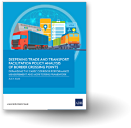Aid for Trade Needs to Catch Up with the Modern World
With mega trade deals and digitalization, we need to rethink aid for trade with more focus on policy and regulatory support.
Aid for trade is based on the idea that trade can be a powerful engine for economic development. It targets trade-related programs and projects—including infrastructure, training and regulatory reform—to help developing countries reap the benefits of international markets and trade.
The effectiveness of aid for trade is currently being debated by donors and recipients, with many feeling that the time has come to reform the system to reflect new challenges.
Since aid for trade began in 2005, there has a been a staggering increase in free trade agreements. Most recently, we have seen mega-regional agreements with ambitious membership, such as the Regional Comprehensive Economic Partnership (RCEP) and the Comprehensive and Progressive Agreement for Trans-Pacific Partnership in Asia and the African Continental Free Trade Area in Africa.
In parallel, new regional digital economy agreements are being put into place, covering areas related to the digital economy, including e-commerce and digital services, in various forms, embedded as chapters of trade agreements, or as stand-alone such as the Digital Economy Partnership Agreement or the recently launched US-Indo-Pacific Economic Framework.
These regional trade deals, and digital economy agreements, have created a host of new negotiating, regulatory and policy challenges for developing countries, and particularly the region’s least developed countries.
To respond to these developments, and the new needs of developing and least developed countries, aid for trade needs to be drastically redesigned to retain its significance.
This includes helping developing countries evaluate proposals, draft regulatory legislation and develop constructive negotiating positions. Limited expertise on trade and international economic laws is an increasing obstacle for developing countries that want to participate in global trade initiatives.
Despite the emerging and long-standing need for aid that targets trade policies and regulations, data show that the value of aid for trade flows amounted only to $0.2 billion in 2020, representing 1.3% of the of aid for trade flows disbursed by official donors to Asia and the Pacific. At the same time, more than $10 billion was disbursed to support economic infrastructure. In addition, most aid for trade flows in this category are directed to individual countries with a minimal amount allocated to regional support.
The continued emphasis of aid for trade assistance on economic infrastructure and training is promoting aid over trade. What is most needed in Asian and Pacific countries, especially those that are least developed, are trade policy makers who understand the value of trade and regulatory policies to foster sustainable economic growth.
To do this, we recommend focusing on the following elements:
- Recognize that trade policies and regulations—the so called “soft infrastructure”—constitute the core of aid for trade assistance.
- Promote and prioritize the use of inter-agency cooperation in delivering trade-related technical assistance, acknowledging specific expertise and comparative advantages.
- Promote regional or sub-regional approaches for cross-border related issues, identifying groups of countries sharing similar priorities and concerns.
- Encourage the building up of regional public goods in the area of trade policy and regulations to complement national support.
- Adopt a forward-looking approach, recognizing that trade policy implementation takes time to generate benefits. This implies moving away from “quick wins” objectives with immediately “visible” benefits that are at present a priority for most donors and the international community.
Donors should take immediate action to redistribute aid for trade disbursements in a more equitable manner across categories, with policy and regulatory support receiving a significant increase. This should be part of an aid for trade paradigm that lives up to the idea that trade can be a fundamental driver of economic growth and social development in developing countries, if given proper support.
Original article was published at the Asian Development Blog and duplicated here with permission from the authors. *




